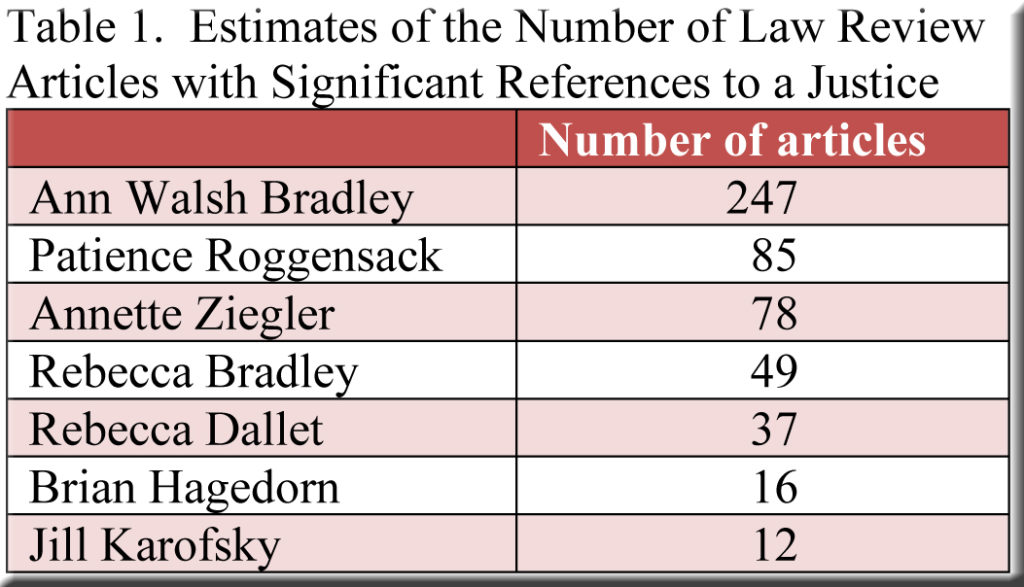Four years ago, as Justice Shirley Abrahamson reached the end of her judicial career, SCOWstats ran a series of posts designed to assess her influence. One such approach drew on techniques employed by Richard Posner to count references in law review articles as a means of comparing justices’ stature or significance.[1] Today we’ll revisit the topic and see what turns up when this method is applied to the current members of the Wisconsin Supreme Court.
For most of the justices, the number of articles containing their names was not overwhelming, and I could go through every one (or a very large representative sample) to search for “false positives”—generally, people who shared a surname with the justice in question. The two Bradleys (Ann Walsh and Rebecca) presented a stiffer challenge, as “Bradley” is not only a common surname but also the first name of numerous members of the American legal profession. Hence the estimates for these two justices (explained in the following footnote) are less precise than the figures for their colleagues.[2]
That said, the information in Table 1 accords with what one would expect—justices with the longest terms of service were cited in the most articles.[3]
Given that the justices all write majority opinions, concurrences and dissents, law review articles cite all seven of them at least occasionally. However, articles also reference what might be called a justice’s voluntary activities, namely published articles (not judicial opinions) and invited addresses delivered to public or professional audiences.[4] These are a subset of the results in Table 1 and furnish a sense of a justice’s level of energy and prominence in the legal profession (Table 2).
Not only are the figures in Table 2 much smaller (understandably) than those in the first table, they also fail to correlate with a justice’s length of service. By this measure, both Justice Roggensack (one of the court’s most senior member) and Justice Dallet (still in her first term) tower above their colleagues. Indeed, for most justices, speeches and publications appear to exert scant attraction—with the total for the court as a whole unlikely to ever approach the previous post’s estimate of 465 for Justice Abrahamson.
[1] See Richard A. Posner, Cardozo: A Study in Reputation (Chicago: University of Chicago Press, 1990). Thanks again to Bill Tyroler for bringing this book to my attention.
[2] As noted, the Nexis Uni searches for Justices Ann Walsh Bradley and Rebecca Bradley turned up a large number of hits—slightly over 2,000 for each. To cope with this volume, I adopted a sampling procedure resembling that used by Posner, which involved taking a random sample of the 2,000+ articles and determining the percentage of articles in this sample that contained references to the justice in question (rather than to some other person who shared the name “Bradley”). The percentage could then be used to approximate the justice’s total number of genuine hits. For example, the search parameters used for Justice Ann Walsh Bradley yielded 2102 hits. I examined every twenty-fifth article (85 altogether) and found that in ten of them Ann Walsh Bradley was indeed the “Bradley” highlighted by the search. Thus, 11.76% (10/85) of the sample hits were genuine, which led to an estimate of 247 genuine hits overall (0.1176 x 2102). The searches for the seven justices were carried out on January 10-12, 2023.
For all justices, the vast majority of hits were to judicial opinions, but a number of other references also turned up, including those to (1) articles the justices authored, (2) speeches they gave, (3) tributes they received, and (4) other comments they made on matters pertaining to the court. As with any selection criteria, there are some gray areas—notably, articles pertaining to a justice’s election campaign. Generally, I have counted articles with references to a campaign if these included substantive quotations from the justice or commentary on controversies associated with the campaign, but I have excluded minor references (such as a note that a justice won reelection in a particular year).
Another question concerns the categorization of critical discussions of a justice’s conduct. Although there are very few such articles for most justices in this study, a handful surfaced regarding Justice Ziegler and past judicial-ethics concerns. Should articles with such commentary be included in a post devoted to assessing a justice’s prominence? In the end, I decided to count these articles, knowing that their small number would not alter the overall impression conveyed by this post.
[3] None approached the estimate of 993 four years ago for Justice Abrahamson.
[4] Interviews with journalists (very few hits) are counted in Table 1 but not in Table 2.


Speak Your Mind